Production
Producers Arthur Gardner, Arnold Laven and Jules Levy sought an inexperienced, and therefore affordable, writer to adapt Hoffman Birney's book The Dice of God into a screenplay. Impressed by Sam Peckinpah's scripts for Gunsmoke , Laven hired Peckinpah to write the screenplay in 1956. Peckinpah worked on the script for more than four months, but the producers were unable to raise funding for the project and it was temporarily abandoned, [2] although Laven worked with Peckinpah in television in the ensuing years. [3]
The project's original title was Custer's Last Stand, but when Twentieth Century-Fox announced its upcoming The Day Custer Fell, later canceled for budgetary reasons, [4] the producers changed the script in order to make the characters fictitious.
In 1965, with funding finally in place, the production of The Glory Guys began. However, under Laven's direction, the film greatly deviated from Peckinpah's script, with heightened emphasis on its romantic elements. [2] Peckinpah later called the film "... a total disaster because of the casting. All the people in the picture were good. That is, they’ve all been good in other pictures but they didn’t really belong in that one. It’s a wretched film. And one of the reasons I’ve made up my mind not to write any more. But I was on the street. I had to write." [5]
The film was shot in Durango, Mexico, and its climactic battle scene involved thousands of extras on 20,000 acres (81 km2) of land. The scene required several weeks of preparation and filming, including training many horses to fall on cue. [2]
The film's total production cost was approximately $1.6 million. [2]
The titles were created by Joseph Mugnaini for Format Productions.
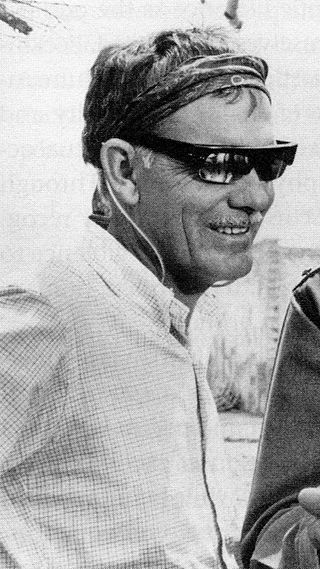
David Samuel Peckinpah was an American film director and screenwriter. His 1969 Western epic The Wild Bunch received two Academy Award nominations and was ranked No. 80 on the American Film Institute's top 100 list. His films employed a visually innovative and explicit depiction of action and violence as well as a revisionist approach to the Western genre.

James Edmund Caan was an American actor. He came to prominence playing Sonny Corleone in The Godfather (1972) – a performance that earned him Academy Award and Golden Globe nominations for Best Supporting Actor. He received a motion-picture star on the Hollywood Walk of Fame in 1978.

Senta Verhoeven is an Austrian-German actress. She received many award nominations for her acting in theatre, film, and television; her awards include three Bambi Awards, two Romys, an Adolf Grimme Award, both a Deutscher and a Bayerischer Fernsehpreis, and a Goldene Kamera.

George Harvey Presnell was an American actor and singer. He began his career in the mid-1950s as a classical baritone, singing with orchestras and opera companies throughout the United States.
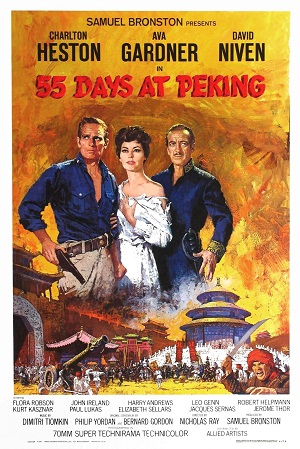
55 Days at Peking is a 1963 American epic historical war film dramatizing the siege of the foreign legations' compounds in Beijing during the Boxer Uprising, which took place in China in the summer of 1900. It was produced by Samuel Bronston for Allied Artists, with a screenplay by Philip Yordan and Bernard Gordon, and with uncredited contributions from Robert Hamer, Julian Halevy, and Ben Barzman. Noel Gerson wrote a screenplay novelization in 1963 under the pseudonym "Samuel Edwards".

Martin Nelson Ransohoff was an American film and television producer, and member of the Ransohoff family.

Thomas Lester Tryon was an American actor and novelist. As an actor, he was billed as Tom Tryon and is best known for playing the title role in the film The Cardinal (1963), featured roles in the war films The Longest Day (1962) and In Harm's Way (1965), acting with John Wayne in both movies, and especially the Walt Disney television character Texas John Slaughter (1958–1961). Tryon later turned to the writing of prose fiction and screenplays, and wrote several successful science fiction, horror and mystery novels as Thomas Tryon.
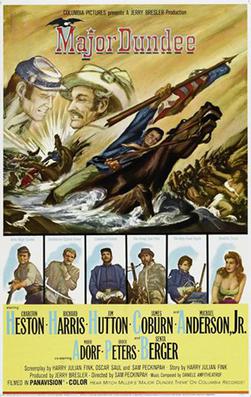
Major Dundee is a 1965 American Western film directed by Sam Peckinpah and starring Charlton Heston, Richard Harris, Jim Hutton, and James Coburn. Written by Harry Julian Fink, the film is about a Union cavalry officer who leads a contentious troop of Army regulars, Confederate prisoners, and Indian scouts on an expedition into Mexico during the American Civil War to destroy a band of Apaches who have been raiding United States bases and settlements in the New Mexico territory. Major Dundee was filmed in various locations in Mexico. The movie was filmed in Eastman Color by Pathécolor, print by Technicolor.
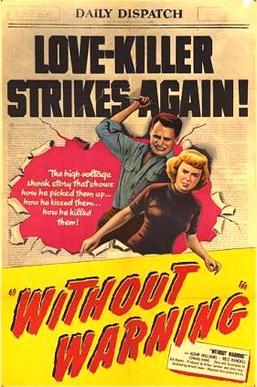
Without Warning! is a 1952 American film noir crime film directed by Arnold Laven and starring Adam Williams, Meg Randall, and Ed Binns. The film is shot in a semidocumentary-style with police procedural voice-over narration in parts. Without Warning! was released commercially for the first time on DVD in 2005. Previously, the film was considered lost and unavailable for viewings.

Sam Whiskey is a 1969 American Western comedy film shot in DeLuxe Color and directed by Arnold Laven, starring Burt Reynolds, Angie Dickinson, Clint Walker and Ossie Davis. "Way ahead of its time," said Reynolds of the film. "I was playing light comedy and nobody cared."

The Power is a 1968 American tech noir thriller film from MGM, produced by George Pal, directed by Byron Haskin, that stars George Hamilton and Suzanne Pleshette. It is based on the 1956 science fiction novel The Power by Frank M. Robinson.

Red Line 7000 is a 1965 American action sports film released by Paramount Pictures. It was directed by Howard Hawks, who also wrote the story. It stars James Caan, Laura Devon and Marianna Hill in a story about young stock-car racers trying to establish themselves and about the complicated romantic relationships in their lives. The title refers to the red line on the car’s tachometer, set at 7000 RPM, indicating the maximum safe engine speed, beyond which catastrophic failure would occur. The film features multiple sections of real life racing and crashes interspersed with the plot.

Arnold Laven was an American film and television director and producer. He was one of the founders and principals of the American film and television production company Levy-Gardner-Laven. Laven was a producer of, among other things, the western television series The Rifleman and The Big Valley. He also directed motion pictures, including Without Warning!, The Rack, The Monster That Challenged the World, Geronimo, Rough Night in Jericho, and Sam Whiskey. In the 1970s and early 1980s, Laven directed dozens of episodes of television series, including episodes of Mannix, The A-Team, Hill Street Blues, The Six Million Dollar Man, Fantasy Island, The Rockford Files and CHiPs.
Arthur Gardner was an American actor and film producer. He was known for his television western, The Rifleman. He was a voting member of the Academy of Motion Picture Arts and Sciences.
Levy-Gardner-Laven Productions was an American film production company based in Beverly Hills, California. The principals, Jules V. Levy, Arthur Gardner, and Arnold Laven, met while serving in the Air Force's First Motion Picture Unit during World War II. While serving, they decided to form their own production company after the war ended. The three men formed Levy-Gardner-Laven in 1951.

Two on a Guillotine is a 1965 American horror film produced and directed by William Conrad and starring Connie Stevens. The screenplay by John Kneubuhl and Henry Slesar is based on a story by Slesar. The movie would be the first in a series of low-budget suspense dramas made by Warner Bros in the vein of the successful William Castle films, and was followed by My Blood Runs Cold and Brainstorm, both also released in 1965 with Conrad as director. A fourth movie, The Thing at the Door, was proposed, but never made.
Jules Victor Levy was an American television and film producer. Levy's television series include The Rifleman, The Detectives, and The Big Valley.

Geronimo is a 1962 American Western film made by Levy-Gardner-Laven and released by United Artists, starring Chuck Connors in the title role. The film was directed by Arnold Laven from a screenplay by Pat Fielder, filming took place in Sierra de Órganos National Park in the town of Sombrerete, Mexico.
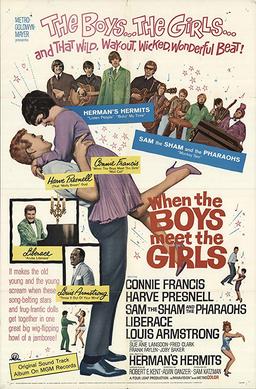
When the Boys Meet the Girls is a 1965 American musical film directed by Alvin Ganzer and starring Connie Francis and Harve Presnell based on the musical Girl Crazy and a remake of MGM's 1943 film Girl Crazy.
Lou Lombardo was an American filmmaker whose editing of the 1969 film The Wild Bunch has been called "seminal". In all, Lombardo is credited on more than twenty-five feature films. Noted mainly for his work as a film and television editor, he also worked as a cameraman, director, and producer. In his obituary, Stephen Prince wrote, "Lou Lombardo's seminal contribution to the history of editing is his work on The Wild Bunch (1969), directed by Sam Peckinpah. The complex montages of violence that Lombardo created for that film influenced generations of filmmakers and established the modern cinematic textbook for editing violent gun battles." Several critics have remarked on the "strange, elastic quality" of time in the film, and have discerned the film's influence in the work of directors John Woo, Quentin Tarantino, Kathryn Bigelow, and the Wachowskis, among others. While Lombardo's collaboration with Peckinpah lasted just a few years, his career was intertwined with that of director Robert Altman for more than thirty years. Lombardo edited Altman's 1971 film McCabe & Mrs. Miller (1971), which had "a radical approach to the use of dialogue and indeed other sound, both in and beyond the frame." Towards the end of his career Lombardo edited Moonstruck (1987) and two other films directed by Norman Jewison. While his editing is now considered "revolutionary" and "brilliant", Lombardo was never nominated for editing awards during his career.
















